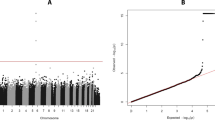Abstract
Objective
The aim of this study was to characterize the population frequency of SLCO1B1 polymorphic variants in three distinct healthy Asian populations, namely Chinese (n = 100), Malay (n = 100) and Indian (n = 100), and to explore the association between haplotype-tagged single nucleotide polymorphisms (htSNPs) on hepatic SLCO1B1 mRNA expression.
Methods
The distribution of polymorphic variants in the SLCO1B1 gene at eight loci that spanned approximately 48 kb was investigated in the three different Asian ethnic groups and in 32 non-cancerous liver tissues from Chinese patients.
Results
Of the 26 polymorphisms screened, we found eight polymorphic variants that differed in genotypic and allelic frequencies between the Chinese, Malay and Indian populations. Significant interethnic differences were observed in the genotype frequency distributions across the promoter SNP [g.-11187G>A (P = 0.030)] as well as three coding region SNPs [c.388G>A (P < 0.001); c.571T>C (P < 0.001); c.597C>T (P < 0.001)] in the healthy subjects. Haplotype analysis revealed 12 different haplotypes in both the Chinese and Malay populations and 18 haplotypes in the Indian population. In both the Malay and Indian populations, the htSNPs were c.388A>G, c.571T>C and c.597C>T, whereas in the Chinese population they were g.-11187G>A, c.388A>G and c.597C>T. The c.388A>G and c.597C>T htSNPs accounted for more than 70% of the variations between the three major haplotypes in each Asian ethnic group. In terms of the c.388A>G htSNPs, genotypic-phenotypic association analyses revealed that there was no effect on SLCO1B1 expression in hepatic tissues; in addition, no genotypic-phenotypic associations were evident with regards to the c.597C>T htSNP.
Conclusion
Future studies should investigate the phenotypic effects of the c.388A>G htSNP on the disposition of OATP1B1 substrates in Asian populations.


Similar content being viewed by others
References
Hagenbuch B, Meier PJ (2003) The superfamily of organic anion transporting polypeptides. Biochim Biophys Acta 1609:1–18
Suzuki H, Sugiyama Y (2000) Transport of drugs across the hepatic sinusoidal membrane: sinusoidal drug influx and efflux in the liver. Semin Liver Dis 20:251–263
Abe T, Kakyo M, Tokui T, Nakagomi R, Nishio T, Nakai D et al (1999) Identification of a novel gene family encoding human liver-specific organic anion transporter LST-1. J Biol Chem 274:17159–17163
Konig J, Cui Y, Nies AT, Keppler D (2000) A novel human organic anion transporting polypeptide localized to the basolateral hepatocyte membrane. Am J Physiol Gastrointest Liver Physiol 278:G156–G164
Kullack-Ublick GA, Ismair MG, Steiger B, Landmann L, Huber R, Pizzagalli F et al (2001) Organic anion-transporting polypeptide B (OATP-B) and its functional comparison with three other OATPs of human liver. Gastroenterology 120:525–533
Tamai I, Nezu Ji, Uchino H, Sai Y, Oku A, Shimane M et al (2000) Molecular identification and characterization of novel members of the human organic anion transporter (OATP) family. Biochem Biophys Res Commun 273:251–260
Konig J, Cui Y, Nies AT, Keppler D (2000) Localization and genomic organization of a new hepatocellular organic anion transporting polypeptide. J Biol Chem 275:23161–23168
Tirona RG, Leake BF, Merino G, Kim RB (2001) Polymorphisms in OATP-C. Identification of multiple allelic variants associated with altered transport activity among European- and African-Americans. J Biol Chem 276:35669–35675
Nishizato Y, Ieiri I, Suzuki H, Kimura M, Kawabata K, Hirota T et al (2003) Polymorphisms of OATP-C (SLC21A6) and OAT3 (SLC22A8) genes: consequences for pravastatin pharmacokinetics. Clin Pharmacol Ther 73:554–565
Nozawa T, Nakajima M, Tamai I, Noda K, Nezu J, Sai Y et al (2002) Genetic polymorphisms of human organic anion transporters OATP-C (SLC21A6) and OATP2B1 (SLC21A9): allele frequencies in the Japanese population and functional analysis. J Pharmacol Exp Ther 302:804–813
Kameyama Y, Yamashita K, Kobayashi K, Hosokawa M, Chiba K (2005) Functional characterization of SLCO1B1 (OATP-C) variants, SLCO1B1*5, SLCO1B1*15 and SLCO1B1*15 + C1007G, by using transient expression systems of HeLa and HEK293 cells. Pharmacogenet Genomics 15:513–522
Xiang X, Jada SR, Li HH, Fan L, Tham LS, Wong CI et al (2006) Pharmacogenetics of SLCO1B1 gene and the impact of *1b and *15 haplotypes on irinotecan disposition in Asian cancer patients. Pharmacogenet Genomics 16:683–691
Drysdale CM, McGraw DW, Stack CB, Stephens JC, Judson RS, Nandabalan K et al (2000) Complex promoter and coding region beta-2 adrenergic receptor haplotypes alter receptor expression and predict in vivo responsiveness. Proc Natl Acad Sci USA 97:10483–10488
Mwinyi J, Johne A, Bauer S, Roots I, Gerloff T (2004) Evidence for inverse effects of OATP-C (SLC21A6) 5 and 1b haplotypes on pravastatin kinetics. Clin Pharmacol Ther 75:415–421
Pasanen MK, Backman JT, Neuvonen PJ, Niemi M (2006) Frequencies of single nucleotide polymorphisms and haplotypes of organic anion transporting polypeptide 1B1 SLCO1B1 gene in a Finnish population. Eur J Clin Pharmacol 62:409–415
Iwai M, Suzuki H, Ieiri, Otsubo K, Sugiyama Y (2004) Functional analysis of single nucleotide polymorphisms of hepatic organic anion transporter OATP1B1 (OATP-C). Pharmacogenetics 14:749–757
Acknowledgements
The authors would like to thank the Singapore Cancer Syndicate (SCS-PS0023) and NMRC (NMRC/0814/2003) for funding this project.
Author information
Authors and Affiliations
Corresponding author
Additional information
An erratum to this article can be found at http://dx.doi.org/10.1007/s00228-007-0336-y
Rights and permissions
About this article
Cite this article
Jada, S.R., Xiaochen, S., Yan, L.Y. et al. Pharmacogenetics of SLCO1B1: haplotypes, htSNPs and hepatic expression in three distinct Asian populations. Eur J Clin Pharmacol 63, 555–563 (2007). https://doi.org/10.1007/s00228-007-0285-5
Received:
Accepted:
Published:
Issue Date:
DOI: https://doi.org/10.1007/s00228-007-0285-5




